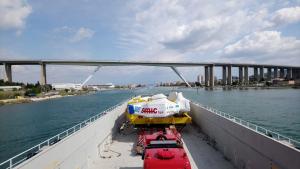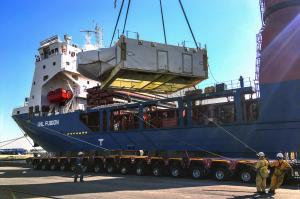Two coils on their way
For the past five years, "highly exceptional loads" (HEL) have been successfully travelling along the ITER Itinerary to be delivered to the ITER site. As the project now enters machine assembly phase, a new category of components is heading to Saint-Paul-lez-Durance. Dubbed "super HEL," they combine exceptional value, size and weight and come with renewed challenges which the global health crisis makes even more daunting.
Procured by Europe and finalized in Italy, toroidal field coil #9 (TF9) was unloaded on 18 March and crossed the inland sea Etang-de-Berre five days later.
A second toroidal field coil (TF12), procured by Japan, left the port of Kobe on 7 March and arrived at Fos-sur-Mer on 7 April—one month later to the day.
Over the past five years, 75 HEL have been safely delivered to ITER. None, however, matched the dimensions and weight—20 metres long, slightly more than 10 metres wide, 600 tonnes with support frame and trailer—of these "Super HEL," the first in a series of two dozen truly exceptional loads to be delivered in the next few years.
To the challenges of transporting such behemoths over the 104-kilometre ITER Itinerary, the global health crisis has added extra constraints. The organization of the convoys, the logistics and the schedule all needed to be adapted to mitigate risk for the loads and guarantee optimal health and safety conditions for the personnel involved.
According to the latest information, the operation will unfold as follows: TF9 will leave its temporary staging area on the northern shore of Etang-de-Berre on 13 April, Easter Monday, and reach the ITER site in the early morning of 17 April. As soon as the component is unloaded, the trailer will be disassembled, shipped back to Berre by truck, and reassembled there. Ideally the trailer, by then loaded with TF12, could be ready to travel on 21 April and arrive at ITER in the early hours of Saturday 25 April.
ITER convoys do not travel on weekends or holidays, but an exception was made for this unique situation. "The French authorities, the gendarmerie, and the thruway operators have all been extremely supportive," says François Genevey, who manages ITER transport operations for the project's global logistics provider DAHER. "Everyone is aware of the importance and challenges of this double operation."



